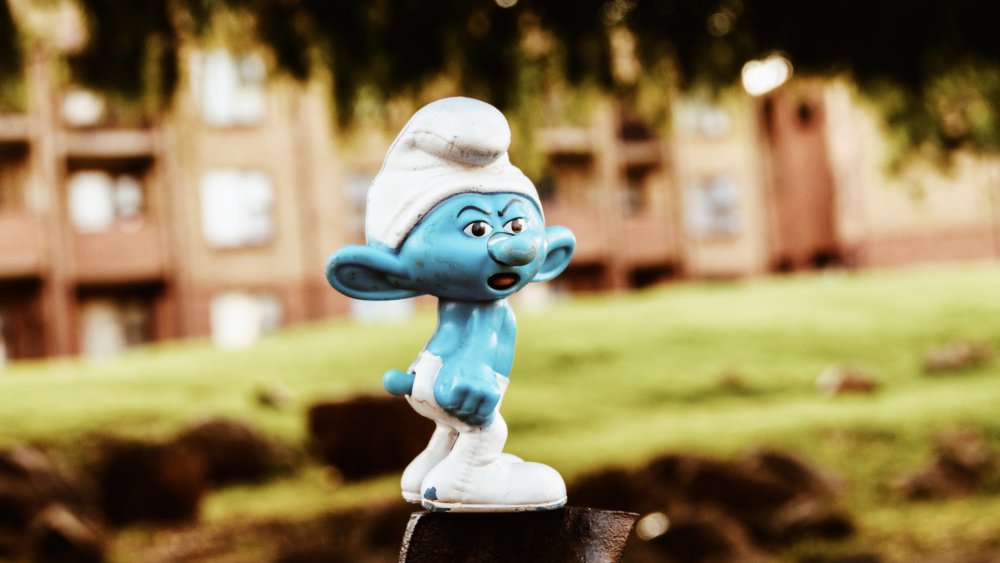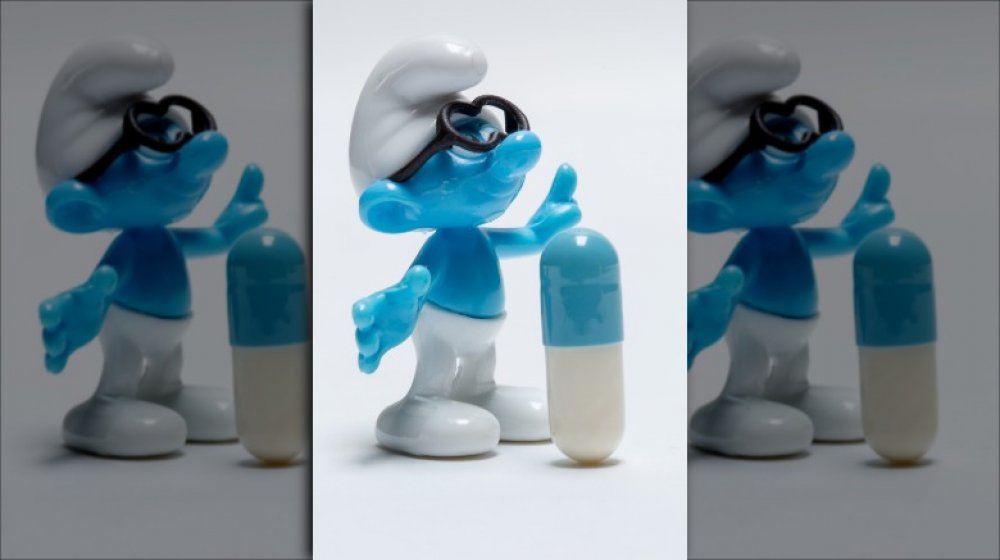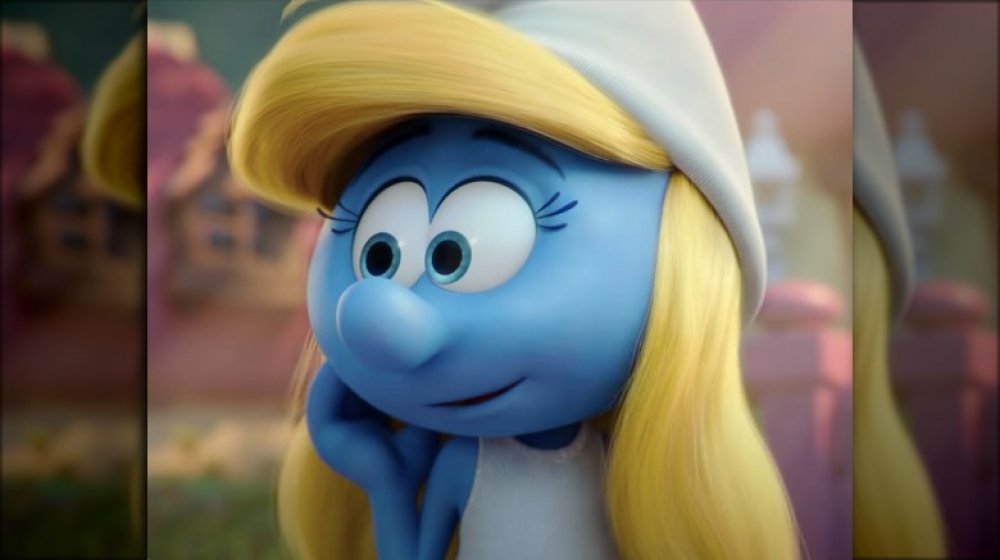Weird Things You Didn't Know About The Smurfs
On the surface, Smurfs are cute and affable creatures. Their cheerfulness and strength of character have warmed many a jaded heart since comics and cartoons began documenting their heroics — most notably in the 1950s and 1980s. But steel yourself. The hidden ways of Smurfkind can be deeply confronting to the uninitiated, and hostile to the gentle demands of human decency. Prepare to question your most basic assumptions about these mushroom-fixated arboreal ingenues.
But first, a quick recap on what we do know.
According to the Terminally Incoherent Blog, Smurfs are "short, bipedal intelligent humanoids." Despite the unsettling blue hue of their skin, there's something oddly familiar in the morphology of your garden-variety Smurf. Gifted with cunning intelligence, nimble opposable digits, and a natural proclivity to tackle challenges collectively, these creatures provide an uncanny reflection of the human condition.
On one level, as Wired reports, the social fabric of daily life in Smurf Village is extremely rudimentary — something akin to how a Medieval human settlement might be organized. "You had a baker, you had an artist, you had a handyman – every Smurf had a talent (and was thus named to avoid confusion.)" On another level, a remarkably complex caste system pervades Smurf life. Those identified as Lazy, Dreamy or Grumpy are forever consigned to the social periphery.
How are these roles ascribed? Such matters are beyond the ken of current conventional approaches to biological taxonomy. One thing is clear. Our sometimes dangerous fascination with Smurfdom is filled with unknowns.
Smurfs may be fatally vulnerable to neuropathogens
It's common knowledge that Gargamel — the hirsute, disproportionally-nosed wizard with questionable hygiene — was a generally negative influence on Smurf quality of life. But even if Gargamel had never awakened to the insatiable desire for Smurf-flesh, the lives of these diminutive hominids wouldn't be as carefree as you might imagine.
Smurfs likely possess an unusually fragile immune system, according to the documentary The Purple Smurf, originally airing in 1981. When an unidentified insect stung Lazy Smurf, a catastrophic contagious neurotoxin swept through Smurf Village in a matter of minutes. As Slash Film reports, infected Smurfs "turned an alarming shade of purple and began to shout GNAP GNAP!". Disaster was averted when Papa Smurf commenced inoculation trials on an infected Smurf, but this only raises deeper critical concerns about Smurf society's stance on medical ethics.
Smurfs lead a precarious existence, and their fragile physical condition is only exacerbated by their tendency to seek out unnecessary adventures in pathogen-rich environments.
Then there's the gender problem
There's also the difficult matter of gender. As pointed out in The Atlantic's searing exposee, "there's something odd about Smurfette, the lone female Smurf." Far from being a plucky, sky-hued female role model with a penchant for picking wildflowers, Smurfette is in fact a dangerous golem wrought by Gargamel. Smurf historians postulate she was created for the sole purpose of sowing discord among the healthily asexual all-male commune of Smurf village. It was only through well-meaning — but very real — cosmetic adjustment magic that Papa Smurf was able to transform Smurfette into the physically acceptable specimen of Smurfy womanhood she later became. The whole scenario is filled with ominous possibilities.
But what if your mind rejects this dismal scenario? The alternatives could send a person spiraling into a miasma of grim realizations. Is the rarity of female Smurfs some fatal genetic flaw within the tribe's gene pool? Are these frail and elusive creatures doomed to extinction in mere decades, with younger Smurfs watching in dismay as their numbers slowly dwindle to nothingness? But if female Smurfs are indeed born... where are they? What is being done to them?
Smurfkind may well greet life's challenges with a cheerful smile and a song in their hearts — and all in an oddly convenient twenty-minute time slot. But perhaps behind that affability lies shadows of a much darker shade of blue.
Smurfs are biologically unique
Setting aside for a moment the possibility that Smurfs are entirely fictional, it's worth pointing out that assuming they do exist, they're biologically unique. The previously cited Terminally Incoherent article leaves a tantalizing trail of clues here. First, the removal of one's hat appears to be taboo for these creatures. Why? Then there's the unusual fact that a gifted (albeit widely-shunned) wizard repeatedly failed to breed Smurfs in captivity for research purposes. How can this be?
One interesting theory posited in Terminally Incoherent's seminal foray into Smurf morphology is that Smurfs are, in fact, mushroom symbiotes. The implications are dizzying. Perhaps the hat isn't a hat at all, but the cap of a psychoactive mushroom with a direct biological pathway leading directly to the Smurf's frontal cortex. If so, removal of the cap wouldn't merely cause social embarrassment. The act would be tantamount to performing a complete and likely irreversible lobotomy.
In one fell swoop, this theory covers off the mystery of Smurf reproduction and perhaps offers an intriguing explanation for why Smurfs seem to have an endless supply of mushrooms for habitation, ingenious evasion mechanisms, and so forth. Perhaps the entire Smurf community is some kind of meta-organism, an intelligent fungus unknown to (again, admittedly fictional) science?
It all begs the question: Is Smurf/human reproduction viable? While shrouded in mystery, history offers tantalizing clues that Homo Smurfeus may indeed once have roamed this planet. There's so much we've yet to learn.



